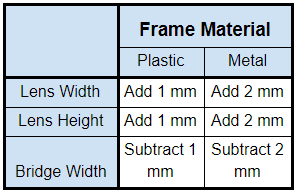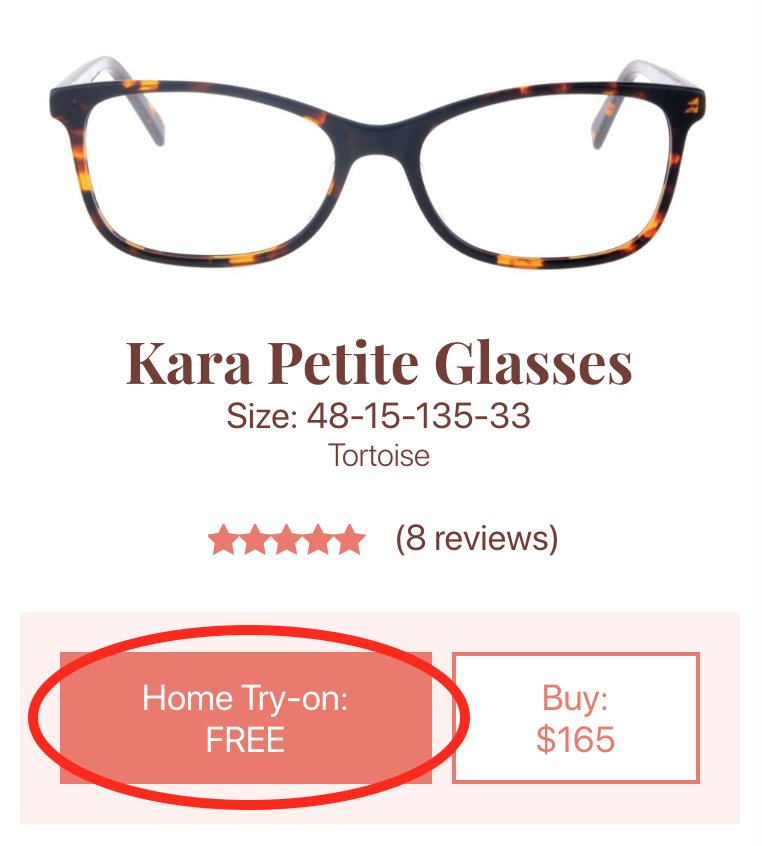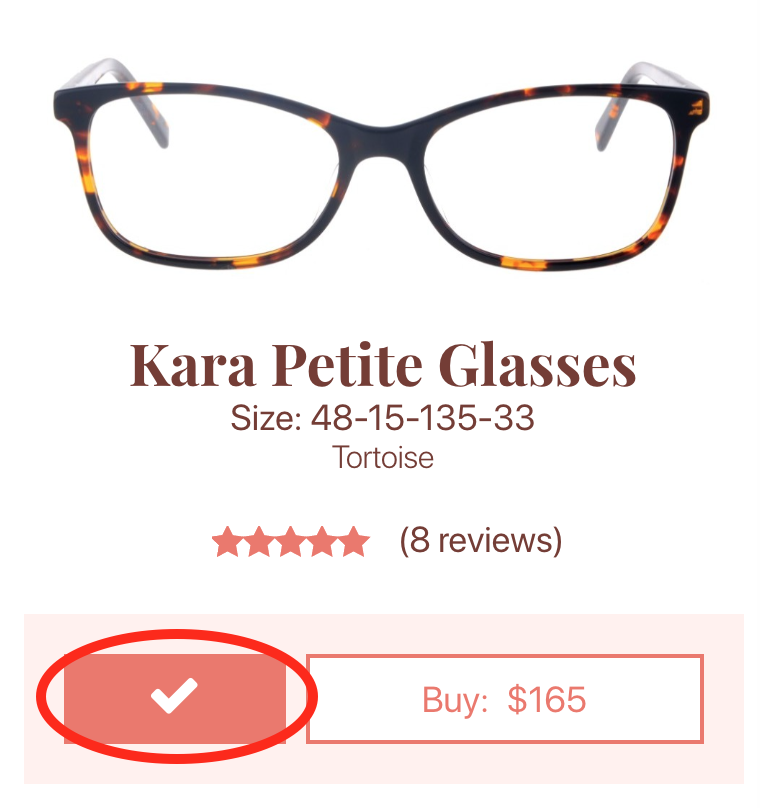Glasses sizes are actually just the measurements of the frame in millimeters. Imagine a box placed around the lens:

To get the size, we measure the distance between and within the boxes. That gives us:
- Lens Width (Eye Size)
- Bridge Width
- Lens Height (B Measure)

The temple length is the length of the temple from from the hinge (where it attaches to the frame front) to the tip.
- Temple Length

Size is printed on the frame
These measurements are usually printed on the frame, on the inside of the temple or behind the bridge.
Some of the measurements may be left out. It’s common to print only the lens width and bridge width, for example.
The formatting varies a bit, but the measurements always appear in the same order.

If a pair of glasses has these measurements…
- Lens Width: 49
- Bridge Width: 16
- Temple Length: 135
- Lens Height: 40
…below is what you might find printed on the frame.
Lens Width – Bridge Width
49□16
49-16
Lens Width – Bridge Width – Temple Length
49□16 135
49-16-135
Lens Width – Bridge Width – Temple Length – Lens Height
49□16-135 B40
49-16-135 B40
49-16-135-40
What size do you need?
Now you know how sizing works. Let’s figure out what size you need.
Read it off your old pair
If your old frames fit well, then others with the same dimensions will fit pretty well too.
Grab your glasses and look for the size information printed on the frame.
Look it up online
Sometimes the size isn’t printed on the frame, but the brand and model are.
You can use this information to find your frames online. Retailers who carry them will usually list the size.
The model can be:
- A word: Kate Spade Rebecca
- A number: Ray-ban 5041
Type this into a search engine and see what you find.
If all else fails, measure by hand
Can’t find the size of your current pair? Simply take out a ruler (with millimeters) and measure it yourself. Use the boxing method described above.
Adjust for accuracy
Glasses sizes are technically for the lenses, not the frames.
But the lenses extend invisibly into the frames a little ways. That’s how they are held in place. So, they are a little larger than what you can see.
When you are measuring by hand, you have to account for the part of the lens that is invisible.
Use these simple adjustments for a more accurate measurement:

For example, let’s say you have plastic frames and you measure by hand:
- Lens width 48
- Bridge width 18
The actual size you need is:
- Lens width 49
- Bridge width 17
“I’ve never had a pair that fit me well.”
How frustrating! In this case, you will need to estimate your size.
Even if your old pair fits badly, they can still be useful as a jumping off point.
Put them on and stand in front of a mirror. What would you like to be different about them? Are they too wide? Too tall? Not tall enough?
If you can tell how you’d like them to fit differently, then grab a ruler. Visualize where you’d like the frame to sit, and measure the difference.
Glasses sizes are actually just the measurements of the frame in millimeters. Imagine a box placed around the lens:

To get the size, we measure the distance between and within the boxes. That gives us:
- Lens Width (Eye Size)
- Bridge Width
- Lens Height (B Measure)

The temple length is the length of the temple from from the hinge (where it attaches to the frame front) to the tip.
- Temple Length

Size is printed on the frame
These measurements are usually printed on the frame, on the inside of the temple or behind the bridge.

These measurements are usually printed on the frame, on the inside of the temple or behind the bridge.
Some of the measurements may be left out. It’s common to print only the lens width and bridge width, for example.
The formatting varies a bit, but the measurements always appear in the same order.
If a pair of glasses has these measurements…
- Lens Width: 49
- Bridge Width: 16
- Temple Length: 135
- Lens Height: 40
…below is what you might find printed on the frame.
Lens Width – Bridge Width
49□16
49-16
Lens Width – Bridge Width – Temple Length
49□16 135
49-16-135
Lens Width – Bridge Width – Temple Length – Lens Height
49□16-135 B40
49-16-135 B40
49-16-135-40
What size do you need?
Now you know how sizing works. Let’s figure out what size you need.
Read it off your old pair
If your old frames fit well, then others with the same dimensions will fit pretty well too.
Grab your glasses and look for the size information printed on the frame.
Look it up online
Sometimes the size isn’t printed on the frame, but the brand and model are.
You can use this information to find your frames online. Retailers who carry them will usually list the size.
The model can be:
- A word: Kate Spade Rebecca
- A number: Ray-ban 5041
Type this into a search engine and see what you find.
If all else fails, measure by hand
Can’t find the size of your current pair? Simply take out a ruler (with millimeters) and measure it yourself. Use the boxing method described above.
Adjust for accuracy
Glasses sizes are technically for the lenses, not the frames.
But the lenses extend invisibly into the frames a little ways. That’s how they are held in place. So, they are a little larger than what you can see.
When you are measuring by hand, you have to account for the part of the lens that is invisible.
Use these simple adjustments for a more accurate measurement:

For example, let’s say you have plastic frames and you measure by hand:
- Lens width 48
- Bridge width 18
The actual size you need is:
- Lens width 49
- Bridge width 17
“I’ve never had a pair that fit me well.”
How frustrating! In this case, you will need to estimate your size.
Even if your old pair fits badly, they can still be useful as a jumping off point.
Put them on and stand in front of a mirror. What would you like to be different about them? Are they too wide? Too tall? Not tall enough?
If you can tell how you’d like them to fit differently, then grab a ruler. Visualize where you’d like the frame to sit, and measure the difference.



Do you sell reading glasses
Hi Amy,
Thanks for asking! For now, I sell frames only and don’t offer any kind of prescription or reading lenses. I hope to offer lenses in the future.
That said, all frames can be fitted with reading lenses by your optician. This is more expensive than the reading glasses that you pick up at the drugstore, but offers a more accurate prescription.
I want to say thank you for such clear and specific guidelines for matching frames with a narrow face. Ultimately, it seems I have a long, narrow face on a big Irish head so most of your frames are likely too small for me. You’re lovely and I appreciate you pointing me in the right direction!🤓🦄🌈😉
Thank you so much for sharing, Maura! It’s true that some people have faces that are long and thin in terms of face shape (oblong) but not necessarily a small in overall size. Thanks so much for stopping by and sharing your appreciation 🙂
Thank you for doing this!!! I have been wearing children’s glasses for years, and loathing the search for frames. Salespeople always think I’m just super picky, but I NEVER like anything they have.
I would love colors like eggplant, burgundy, reddish purple. They are dramatic but not as dark as black. I also love thinner plastic than I usually find.
Hi Donna, Thanks so much for your lovely comment. We are right to be picky 😉 It’s right that we should have frames we enjoy wearing.
Those are excellent color suggestions, thank you!
Just tried my first selections of petite frames. Wow! My favorite fit ever. Can’t wait for more vibrant color in your acetate frames. 46 width Julie in greens please!
Ooh, fun! Thank you for sharing that color request. So glad to hear it was a good fit for you!
Do you know where to get any glasses which are for VERY petite faces? I can’t go larger than the ones I currently have based on my pupilarly distance and the strength of prescription and severity of my astigmatism and I’ve been unable to get a new pair to suit my prescription for way too many years now. I’ve never had my eyesight corrected to 20:20 because its too poor for that, but my current glasses are so out of date I’ve been getting headaches and my closest opticians seem to have stopped selling anything in the size I need.
My current glasses fit fantastically but are terribly worn out and already had one lens change. I got two pairs of the exact same style at the same time, one as sunglasses and wore the regular ones to death and when I needed a new prescription they didn’t have any which would fit me any more (all were a few mm too big or the wrong shape) so I got the sunglasses pair which I’d barely worn replaced with my new prescription. I’ve now worn these to the point that the plastic ends are wearing away and they’ve got a bit scratched up too like the previous daily wear set. So I’m out of glasses frames to reuse (I couldn’t get these done even if I wanted to as they took the old pair so I’d have nothing to wear whilst they replaced the lenses and I can’t see without them).
The size I need is 45-16-130 with the total frame width of 121mm. I can’t really do wider than that, these are the widest frame width I’ve ever had and any wider and they’d not sit on my ears at all! I’ve tried measuring the lens height because the ones listed here seem to be larger than mine are and they’re 24mm tall, or 26mm tall including the metal frame. I can’t really do much taller than that as I have very high and prominent cheekbones and taller glasses dig into them painfully, plus hit my eye socket ridge at the top. From top of my cheekbone to bottom of my eye socket ridge is 30mm, so I can’t go taller than that. So round glasses are totally out! My current pair are a softened rounded rectangle kind of shape. Not rounded enough to be oval, but not square enough to be a true sharp rectangle.
I could manage a 15mm bridge too, as again, this pair were on the large side when I got them and I have the nose pieces bent in as far as I can so they’re close enough to sit on my nose properly. So if there are 45-15-130 options that would likely still work.
I noticed that most of the options here are still on the large size and don’t know if that’s just because what counts as a petite frame has changed or not. I basically need what used to get classed as teen frames here before they stopped making that a section in favour of larger glasses. Maybe kids are just getting bigger? I know my head is tiny, but still, even the kids range is starting to be on the larger size!
Thanks for your help!
Hi Alexa,
Thank you so much for reaching out! I always love hearing customer frame requests.
You might try the Kimberly (45-14-130 and total width 116).
The Mini Kara, Joelee, Julie and Nicci are also around 121mm total width or less.
I’d love to hear more about the frames you would like to see in my store. I will follow up privately. Thanks you!
Hello! I am thrilled to have found this site – I have complained so much that eye glass places seem to discriminate against those of us with small/petite faces! Although your selection is still limited, you’ve got some that I can actually wear! However, in terms of sunglasses, I have dry eyes and am photophobic. Therefore, I would be best served by wrap-around frames or at least frames that curve into the side of the face. Per chance have you any plans to design frames like this? Also, because I need progressive lenses, I read that a frame has to be at least be 30mm in height. Do you know if this is true?
Thank you – you have a fantastic niche business and I hope it is/becomes highly successful!
Hi Kathi,
Thank you for your lovely comment! I’m thrilled you found my site as well 🙂
Good to know that there is an interest in wrap-around sunglasses. Thank you for letting me know. I don’t have plans on creating those in the immediate future, but I definitely hope to extend into more sportswear type sunglasses and other small-face products in the future.
28-30 is usually the minimum lens height for progressive lenses (all frames site-wide have 28+ lens height). I always recommend doing more than the minimum, if your face can handle it (so, 33-35 is even better).
Thank you for visiting, I hope you find a good fit!
Hi! Would any of these glasses fit those with a low bridge? I’m tired of shoving glasses up my face (even with the metal ones with nose pads) and just learned that I have a low bridge (which explains a lot). My current pair I’ve kept for far too long because the lens height is 29mm, and I don’t want to wear current styles that would drown my face.
Hi Mara, Thanks for your question! Our Phyllis Petite Glasses is low bridge fit. Currently low stock but we will offer them on pre-order again when they run out.
Phyllis Crystal Rose